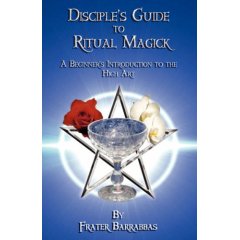
The goal of Frater Barrabbas’ Disciple’s Guide to Ritual Magick is to initiate the reader into the mysteries of ritual magick. In 1988, Frater Barrabbas and others began the Order of the Gnostic Star, or Egregore Sancta Stella Gnostica (E.S.S.G.) (p. 12). I initially took an interest in Disciple’s Guide to Ritual Magick because of its clear Thelemic influence. I practice with a OTO-derived magickal group in Oakland. Reading Barrabbas, I am curious about his implementation of OTO ideas and creation of the new tradition, E.S.S.G.
Overall, I am pleased with Barrabbas’ treatment of the subjects. I prefer books with meaningful philosophical or theological inquiry over mechanical handbooks. Part II of Disciple’s Guide to Ritual Magick is a Grimoire of rituals and correspondences. The Disciple’s Guide to Ritual Magick contains tips on starting practices, as promised, but is not short on intellectual spirituality.
Barrabbas describes a purpose of magick thus, “The fourth premise is that the ultimate goal of all magick is union with the Absolute Spirit, whether the practitioner realizes this truth or not” (p. 31). In Barrabbas’ philosophy, the magician unites with Spirit. Barrabbas’ concept is not foreign from other philosophies. The union and the manipulation of forces, magnetic and other, are concepts particularly significant in alchemy. Later, Barrabbas identifies what I believe to be the more common occult philosophy that magick involves the union of God and Goddess or of essential male and female energy. The Great Rite is Barrabas’ example (p. 107). Many perceive the “union” in magick to be the merging of Goddess and God, the blending of core male and female energies, the synchronization of polarity.
Barrabbas contests Aleister Crowley’s definition of magick, “the science and art of causing change to occur in conformity with will,” which Barrabbas believes is too general (p. 37). While Barrabbas agrees that magick is an effective means of change, he believes that a definition of magick should be more specific, for only certain actions qualify as magick.
The presence of Deity is important in Barrabbas’ magick (p. 112). Barrabbas finds less meaningful magickal systems that draw from the energy of Earth without acknowledging the Goddess, who is Earth. Barrabbas has studied multiple ritual magick traditions and does not strictly adhere to any one of them. Even his experience with Ordo Templi Orientis has resulted in a derivative tradition, E.S.S.G. Barrabbas balances intellectual ceremonial magick with popular Pagan theology. Barrabbas is concerned with skillful ritual practice and with Pagan theological ethics.
Barrabbas writes about the importance of peers in magickal practice (p. 50). Many popular books on the subject are written for the solitary practitioner. While Barrabbas includes exercises for the individual, he advocates for communal development of religious or magickal identities. In this style, peers can influence each other positively. When in doubt, ritual magicians might ask their friends of the Craft for advice and opinions on magickal ethics and theology. I like that Barrabbas prioritizes ethics and moral guidelines, which is not suggested in the title nor is a component of every magickal grimoire today. Barrabbas is sensible, creative, and experienced. Now I wonder why you have spent so much time reading my review and have not picked up Disciple’s Guide to Ritual Magick by now!
~review by: Michelle Mueller
Author: Frater Barrabbas
Megalithic Books, 2007
pp. 325, $22.50
